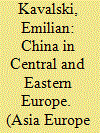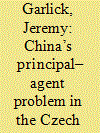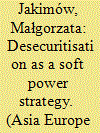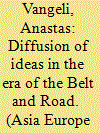|
|
|
Sort Order |
|
|
|
Items / Page
|
|
|
|
|
|
|
| Srl | Item |
| 1 |
ID:
169131


|
|
|
|
|
| Summary/Abstract |
The Central and East European (CEE) part of the Eurasian landmass is often overlooked in the conversations on contemporary geopolitics. Yet, owing to China’s relations with the CEE countries, the region has been subject to growing strategic attention. This article offers a brief overview of the history of this relationship by focusing on the “17+1” mechanism. Nestled within the broader Belt and Road Initiative (BRI), the “17+1” has provided a unique regional arrangement for extending Chinese influence in the sixteen CEE countries. The article inquires whether there is something else than the instrumental economic reasoning for the willingness of CEE countries to partner with China. The analysis detects three distinct strategic narratives motivating the participation of CEE states in the “17+1” mechanism. The study concludes with an enquiry on China’s preparedness to respond to such identity geopolitics not only in the CEE region, but throughout the vast expanse covered by the BRI initiative.
|
|
|
|
|
|
|
|
|
|
|
|
|
|
|
|
| 2 |
ID:
169133


|
|
|
|
|
| Summary/Abstract |
Although it appears that China’s state capitalism model means that state-owned and private companies are utilised in the service of foreign policy goals such as international investments under the umbrella of the Belt and Road Initiative (BRI), the reality is more complex. The behaviour and interests of Chinese commercial actors do not always correspond with the stated aims and strategy of government officials. The article examines Chinese economic diplomacy in the Czech Republic from 2015 to 2018, assessing the extent to which the private company CEFC China Energy acted as an agent of the Chinese state as part of a coordinated strategy designed to increase Chinese economic and political influence via the use of economic incentives. CEFC was at the forefront of Chinese investments in the Czech Republic during this period but CITIC, a Chinese state-owned enterprise (SOE), took over these in May 2018 while the head of CEFC was reportedly being detained in China. The research is theorised in terms of the principal–agent problem, which posits that conflicts of interest and asymmetries of information affect coordination between principals (such as Chinese leaders) and agents (such as private companies). Since the case study reveals conflicts of interest between principals and agents in Chinese state-led economic diplomacy in the Czech Republic, it has implications for understanding the characteristics and practical implications of BRI-framed investment drives in the remainder of the Central and Eastern Europe region.
|
|
|
|
|
|
|
|
|
|
|
|
|
|
|
|
| 3 |
ID:
169129


|
|
|
|
|
| Summary/Abstract |
While much discussion centres on economic properties and political challenges of implementing the China’s Belt and Road Initiative (BRI), few studies investigate the subtle connections between the narratives of the BRI and the political transformations in the regions en route of the project. Through a critique of the Copenhagen School’s theory of securitisation, this paper brings together the analysis of Chinese, Central-Eastern European (CEE) and the core EU governments’ ideas and perceptions of the BRI and assesses what they mean for the future of the European Union’s political and normative cohesion. This paper argues that the China-deployed desecuritised narratives of the BRI constitute an important soft power strategy of China in its engagement in Europe. The article illustrates how these desecuritised narratives are utilised and co-produced actively by countries of CEE with a political aim of negotiating their domestic interests with the EU’s institutions, making the process of desecuritisation neither apolitical nor benign. As China-promoted desecuritisation is used instrumentally by the regional actors to present China as an economic, political and normative alternative to the EU, the article contributes to the understanding of China’s desecuritisation as a soft power strategy, which is both forged through ‘negative’ language (Callahan, Politics 35(3–4):216–229, 2015) and is ‘contingent’ upon recipient audiences (Kavalski, Coop Confl 48(2):247–267, 2013). As a result, new regional dynamics emerge in the EU, which are driven by the populist turn and growing demand for Chinese investments in the European periphery, which China skilfully utilises through narratives of desecuritisation in order to boost its soft power strategy in the region.
|
|
|
|
|
|
|
|
|
|
|
|
|
|
|
|
| 4 |
ID:
169132


|
|
|
|
|
| Summary/Abstract |
To address part of the puzzle on China’s ideational impact in the era of the Belt and Road Initiative (BRI), the article studies social interaction of Chinese and CEE think tanks by employing the concept of diffusion of ideas. The article proposes a theoretical framework to study diffusion inspired by reflexive social science that focuses on frames, (geoeconomic) imaginaries, and translations. The asymmetrical interaction of think tanks led to aligning the frames of the different actors and producing a context of peaceful and pragmatic cooperation, extension of the geoeconomic imaginaries to include previously unorthodox positions, and translation of policy concepts that are localized in accord with the dispositions of the CEE actors involved. Nevertheless, the China–CEE think tank cooperation, when analyzed in a broader context, has relatively limited impact on societal and policy levels, and is increasingly challenged by actors with greater leverage in the region. What sustain the diffusion of ideas are the potent narratives of imagined futures of prosperity under the New Silk Roads.
|
|
|
|
|
|
|
|
|
|
|
|
|
|
|
|
| 5 |
ID:
169128


|
|
|
|
|
| Summary/Abstract |
China’s relations with Central and Eastern Europe (CEE) have been progressively attracting attention in recent years. In the last decade, China sought to restore the “bridges” (Wasserstrom 2000) with the region that had existed in the period 1949–1989. Chinese policymakers have long contemplated their “return” to CEE (Tubilewicz 1998); however, they have found the right opportunity only in the period after the global financial crisis. The first trade and investment summit of China and the sixteen countries in the region—Albania, Bulgaria, Croatia, the Czech Republic, Estonia, Hungary, Latvia, Lithuania, Montenegro, (North) Macedonia, Poland, Romania, Serbia, Slovakia, and Slovenia—took place in Budapest in 2011. In 2012, the first summit of the heads of governments of China and the sixteen (collectively known as 16+1) took place in Warsaw. Ever since, these summits have been taking place once a year, while a web of coordinating institutions and mechanisms spanning a number of policy fields has been also established. There is now a whole new universe of interactions involving governmental actors on the national, regional/provincial, and local levels, state-owned and private enterprises, think tank(er)s, and media professionals, as well as other people-to-people exchanges, which now take place with growing frequency and contribute to development of China–CEE relations.
|
|
|
|
|
|
|
|
|
|
|
|
|
|
|
|
| 6 |
ID:
169134


|
|
|
|
|
| Summary/Abstract |
Narratives about the challenges of China’s growing involvement with Central and Eastern Europe (CEE) for the region and the EU are exponentially proliferating and have already effectively monopolized the understanding of this relationship among scholars, analysts, media, and policy-makers in the Western European capitals. The Western Balkans, as a sub-region of CEE, are thought of as particularly prone to Chinese influence—the countries in this geographical area are not EU members nor are fully integrated in the EU’s policy and legislative frameworks and initiatives yet are interested in maximizing the economic benefits of their relationship with China. By strategically developing ties with the Western Balkans, China is understood to have, or is well on the way to achieve, profound impact in this region. This paper focuses on three policy areas perceived to be both the most important channels and the clearest expressions of China’s influence in the Western Balkans—foreign policy, physical infrastructure and connectivity, and investment. Using the notion of the structural power for its analytical framework, this study finds that while the attention has been on China’s growing presence in the region, the extent to which the EU has since moved to re-assert its leadership in the Balkans has gone under the radar. The paper concludes that in recent years Brussels has reformulated its agenda so as to bind the Balkan states to its own policies and objectives, constraining their ability to independently shape their relationship with Beijing.
|
|
|
|
|
|
|
|
|
|
|
|
|
|
|
|
|
|
|
|
|